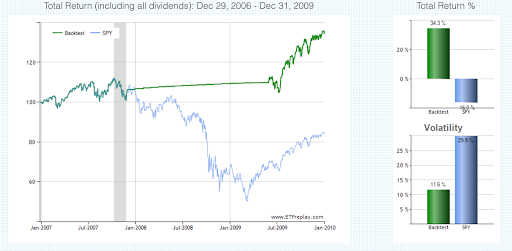Related Blogs
February 17, 2022 | Avalon Team
There’s an important concept that when correctly implemented can almost assure your investing success. 
Get this wrong – and most investors do – and you could be doomed to financial ruin.
Asymmetric investing is the concept of investing where the probability or outcome of a trade has more profit than loss (or the risk taken to achieve the profit).
Said another way, the upside profit potential is greater than the downside loss possibility.
Let me first demonstrate what is NOT an example…
Buying and holding the S&P 500.
Investing in the S&P 500 has had a historic annualized return of 10.5% since 1957.
In the same period, the worst drawdown has been -55% which occurred between November 2007 and March 2009.
The potential of losing 5X–8X your potential return is NOT positive asymmetry, yet investors make this trade all the time when buying and holding index and mutual funds in their 401(k).
Losses themselves are asymmetric.
- A 20% loss requires a 25% gain to get back to even.
- A 50% loss requires a 100% gain to get back to even.
Investors who suffer large losses miss out on the magic of compound returns.
Compounding works only if the return stream is consistent and losses are kept small. You can’t spend your losses.
Asymmetric is not symmetry. Asymmetric is imbalanced: more of one, less of the other.
As investors, we want more gains. More profits. We want less loss. A lot less loss.
And the problem is that most any investment, unmanaged, is negatively asymmetric.
This leads us to…
Asymmetric Risk Management
Put simply, asymmetric risk management is the process of managing risk with the objective of creating a positive asymmetric risk/reward.
Remember I mentioned the worst drawdown in modern history for the S&P 500 occurred in the period between the end of 2007 and 2009?
For many investors, this is a painful memory. Let’s see if we can produce a better outcome through risk management.
In the whitepaper A Quantitative Approach to Tactical Asset Allocation by Meb Faber, the author presents a simple approach of using the 10-month moving average to help improve the performance of a basket of broad asset classes.
The idea is simple enough – own the investment any month in which the closing price of the previous month is greater than the moving average price. If the price is less than the moving average, then the investment is sold and the money is held as cash.
The reason this works is that it puts a line in the sand. It creates a level where downside risk is contained.
Every large loss began with a small loss. The moving average defines where to cut bait and move on.
For our demonstration, let’s apply the 8-month moving average (I find it works better). Our rule is that we will buy and hold the S&P 500 SPDR (SPY) as long as its price remains above the 8-month simple moving average.
Let’s see what happens.

By applying a simple risk management rule, our losing investment into the SPY has been turned into an investment with positive asymmetry.
The return is positive vs. a negative return for buying and holding SPY. More importantly, the maximum drawdown is only -9.9% vs. -55.2%.
 That is an 82% reduction in risk with a higher return!
That is an 82% reduction in risk with a higher return!
Yes, you can earn more and risk less when you invest using positive asymmetry.
And this all happened because of the use of a simple rule that sold SPY on November 30, 2007, and held cash until May 29, 2009, where the strategy went long SPY for the duration of our testing period.
“The essence of investment management is the management of risks, not the management of returns.” – Legendary investor, Benjamin Graham
There are many tools that can be used to create positive asymmetry. We’ll discuss them further in future articles.
For now, remember that long-term, lasting success as an investor is not about having the highest returns. Rather, it’s about investing where risks are managed so that the opportunity for gain exceeds the potential for loss.
If you have any questions or have been considering hiring an advisor, then schedule a free consultation with one of our advisors today. There’s no risk or obligation—let's just talk.
Tags

Free Guide: How to Find the Best Advisor for You
Get our absolutely free guide that covers different types of advisory services you'll encounter, differences between RIAs and broker-dealers, questions you’ll want to ask when interviewing advisors, and data any good financial advisor should know about you and your portfolio.

